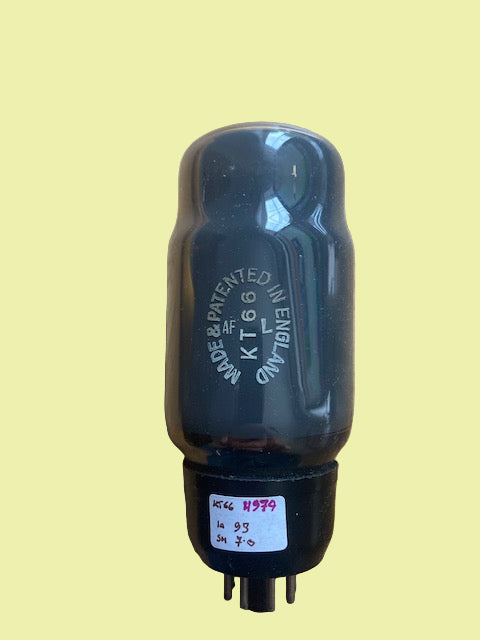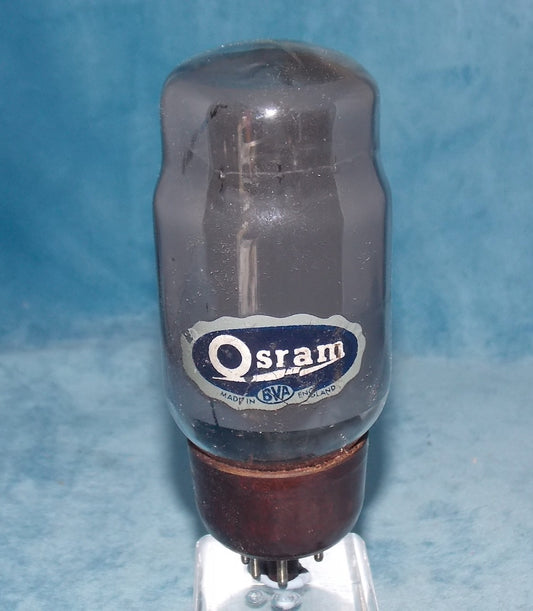Collection: KT66, CV321, CV1075, VT75(RAF), OUTPUT BEAM TETRODE, OCTAL
The KT66 beam tetrode was introduced in 1937 primarily for radar use. But soon became highly acclaimed as an audio output valve.
The KT66 was essentially a 6L6 redesigned to have a larger cathode and a more robust wide section anode but more importantly, the electrodes were configured within the electrode cage to maximize efficiency by positioning of the anode a specific multiple of the distance from the screen grid to cathode distance. A pair of beam deflection plates connected to the cathode were added to focus the electron beam into two discrete planes 180 degrees apart hence providing an elegant solution to limit space charge secondary emission without using an extra suppressor grid.
More importantly, this ‘focussed’ four electrode design mimicked the characteristics of Philips’ power pentode designs but neatly sidestepped their patents.
One important performance benefit of the beam tetrode electrode configuration Is that the beam plates limit the negative resistance kink in the anode current vs anode voltage in the lower regions of the characteristic curves of a full tetrode which could produce instability in Push Pull amplifiers using a full tetrode. Conversely, a beam tetrode does not tolerate poor amplifier design which could suffer unwanted parasitic oscillations.
A further sonic benefit is that the beam tetrode electrode is its inherent stability which manifests as low third harmonic and intermodulation distortion especially in ultra-linear operation. Indeed, beam tetrodes give the lowest recorded distortion of any output valve.
The KT66 has been seen in many presentations over the years. Many prefer the early ‘fat boy’ baluster balloon devices which were used to great effect in the H2S radar during WW2. Although they have a sublime appearance and exquisite sonic performance, care must be taken as these early incarnations of the device are prone to heater-cathode shorts so must be chosen and tested accordingly – especially as they are very expensive and hard to obtain.
More familiar is the classic ‘coke bottle’ shape, earlier devices having an internal charcoal mist screed applied and more typically a black base, with later devices of the same shape having a clear glass envelope allayed to both black and brown Micanol bases which show the copper grid supports and distinctive carburised grey electrode cage to good effect.
Whilst focussing on the KT66, let’s not forget the Mullard EL37 here, an interesting device often touted as Mullard’s equivalent to the KT66 but the EL37 is actually a pentode device!!! It does however make an interesting alternative and many guitar amplifier users prefer the EL37 even though they are not as robust to overloading, have a shorter life than the KT66 – conversely, they do offer a nominal mutual conductance gm of 11.0 mA/V – almost twice that of the KT66 and as a pentode needs only limited signal to drive them, so a unity gain triode gain stage could be de rigeur - something you could never try with a KT66 which needs a good belt of power for healthy driving!!!!
The KT66 sees duty in so many classic hifi and guitar amplifiers it’s hard to know where to start the list, PYE HF91, HFS25, QUAD II, Williamson, the Marshall JTM45




-
CV1075, COSSOR, HIGHBURY PRE SEPT 1945 MANUFACTURE, RED PRINT, CLEAR GLASS, FAT BOY KT66, VT75
Vendor:OSRAM VALVE COMPANYRegular price £320.00 GBPRegular price -
CV1075, MIL SPEC, KT66, GEC, BROWN BASE,GREY GLASS,, DOVER PRODUCTION, MAY 1954, SCARCE DEVICE
Vendor:GEC (M.O. VALVE COMPANY)Regular price £155.00 GBPRegular price -
GEC, FAT BOY KT66, VT75, AIR MINISTRY PRODUCTION, 10E/11533, CLEAR GLASS, BLACK BASE, ELECTRONIC TUBES HIGH WYCOMBE PLANT, WARTIME PRODUCTION
Vendor:OSRAM VALVE COMPANYRegular price £245.00 GBPRegular price -
KT66 OUTPUT BEAM TETRODE SHORT FORM BOXED TESTED
Vendor:BENTLEY ACOUSTICRegular price £14.00 GBPRegular price -
KT66, BENTLEY ACOUSTICS, CLEAR GLASS, 1972 DATED
Vendor:BENTLEY ACOUSTICRegular price £12.00 GBPRegular price -
KT66, GEC, BLACK BASE,GREY GLASS , LARGE OVAL CARTOUCHE, HIGHGROVE PRODUCTION, JUNE 1945,
Vendor:GEC (M.O. VALVE COMPANY)Regular price £155.00 GBPRegular price -
KT66, GEC, BROWN BASE, GREY GLASS , HAMMERSMITH PRODUCTION, APRIL 1955,
Vendor:GEC (M.O. VALVE COMPANY)Regular price £155.00 GBPRegular price -
KT66, OSRAM BROWN BASE,GREY GLASS , LARGE BLUE DECAL, HAMMERSMITH PRODUCTION, JUNE 1955,
Vendor:GEC (M.O. VALVE COMPANY)Regular price £155.00 GBPRegular price -
KT66, TEONEX, CLEAR GLASS,
Vendor:TEONEXRegular price £10.00 GBPRegular price












